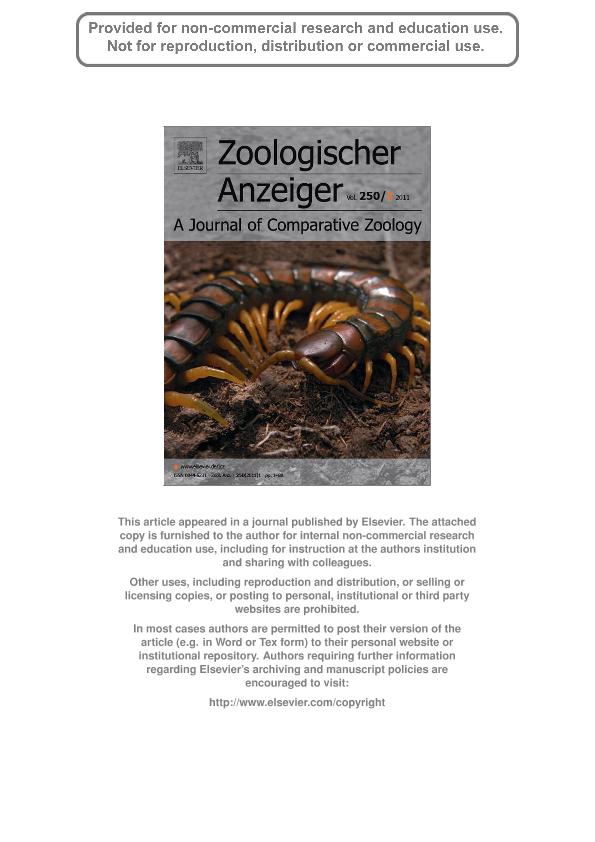Mostrar el registro sencillo del ítem
dc.contributor.author
Estevez, Ana Lia

dc.contributor.author
Ribeiro, José Ricardo Inacio
dc.date.available
2020-01-17T18:12:39Z
dc.date.issued
2011-03
dc.identifier.citation
Estevez, Ana Lia; Ribeiro, José Ricardo Inacio; Weberiella De Carlo, 1966 (Insecta: Heteroptera: Belostomatidae) revisited: Redescription with a key to the genera of Belostomatidae and considerations on back-brooding behaviour; Elsevier Gmbh; Zoologischer Anzeiger; 250; 1; 3-2011; 46-54
dc.identifier.issn
0044-5231
dc.identifier.uri
http://hdl.handle.net/11336/95073
dc.description.abstract
Males of some subgroups of Belostomatidae brood the eggs attached to their backs, whereas the eggs are attached to the vegetation by females in others. Male brood care is obligatory in the belostomatine species of Abedus Stål, 1862, Belostoma Latreille, 1807, Diplonychus Laporte, 1833, Hydrocyrius Spinola, 1850, and Limnogeton Mayr, 1853. Recent investigations into relationships among Neotropical Belostomatinae have led authors to recognize a clade Belostomatinae, which is mainly characterized by back-brooding behaviour. It is likely that Weberiella belongs to this clade. Males of the only described species W. rhomboides (Menke, 1965) are reported as carrying eggs on their back for the first time here. Since this species was described based on a single female specimen from French Guiana, W. rhomboides is redescribed based on specimens from Amazonas, Mato Grosso, Rondônia, and Roraima States, Brazil. Its distribution in Brazil is mapped. The scale-like abdomen is a presumably autapomorphic condition not found in the other belostomatid species. A key to the genera of Belostomatidae including Lethocerinae and Horvathiniinae is provided. Even though a formal parsimony analysis is not presented here, a placement of W. rhomboides in Belostomatinae is tentatively suggested based on the back-brooding behaviour of males as a shared apomorphy. Convergent evolution cannot be excluded as suitable vegetation for depositing eggs is not available in the specific habitat (kinon) of W. rhomboides.
dc.format
application/pdf
dc.language.iso
eng
dc.publisher
Elsevier Gmbh

dc.rights
info:eu-repo/semantics/openAccess
dc.rights.uri
https://creativecommons.org/licenses/by-nc-sa/2.5/ar/
dc.subject
BELOSTOMATIDAE
dc.subject
WEBERIELLA
dc.subject
BACKBROODING
dc.subject
SYSTEMATICS
dc.subject.classification
Zoología, Ornitología, Entomología, Etología

dc.subject.classification
Ciencias Biológicas

dc.subject.classification
CIENCIAS NATURALES Y EXACTAS

dc.title
Weberiella De Carlo, 1966 (Insecta: Heteroptera: Belostomatidae) revisited: Redescription with a key to the genera of Belostomatidae and considerations on back-brooding behaviour
dc.type
info:eu-repo/semantics/article
dc.type
info:ar-repo/semantics/artículo
dc.type
info:eu-repo/semantics/publishedVersion
dc.date.updated
2020-01-15T20:04:16Z
dc.journal.volume
250
dc.journal.number
1
dc.journal.pagination
46-54
dc.journal.pais
Alemania

dc.description.fil
Fil: Estevez, Ana Lia. Consejo Nacional de Investigaciones Científicas y Técnicas; Argentina. Universidad Nacional de La Plata. Facultad de Ciencias Naturales y Museo. Departamento Científico de Entomología; Argentina
dc.description.fil
Fil: Ribeiro, José Ricardo Inacio. Universidade Federal do Pampa; Brasil
dc.journal.title
Zoologischer Anzeiger

dc.relation.alternativeid
info:eu-repo/semantics/altIdentifier/url/https://www.sciencedirect.com/science/article/pii/S0044523110000690
dc.relation.alternativeid
info:eu-repo/semantics/altIdentifier/doi/http://dx.doi.org/10.1016/j.jcz.2010.11.002
Archivos asociados
